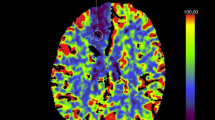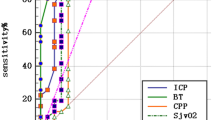Summary
Severe head injury is frequently associated with focal or global disturbances of cerebral blood flow and metabolism. Routine monitoring of intracranial pressure (ICP) and cerebral perfusion pressure (CPP) in these patients does not provide information about critically reduced local or global cerebral blood flow. Measurements of cerebral lactate difference, Lactate-Oxygen-Index (LOI) and cerebral oxygen extraction were evaluated for advanced monitoring by comparing these parameters with ICP, cranial computed tomography (CCT) findings, and outcome in a group of severely head-injured patients.
In 21 patients with severe brain trauma (GCS ⩽8), arterial as well as jugular venous lactate levels and oxygen saturation were measured in vitro every 6 h after admission of patients to the intensive care unit (ICU) throughout the acute course of treatment. Arterial blood pressure, blood gases, and ICP were assessed by standard monitoring measurements. CCT was performed initially after admission of the patients to the hospital, during the acute period in the ICU, if indicated, and 10 to 14 days after trauma. Outcome was classified according to the Glasgow outcome scale (GOS) at six months after injury. Data were averaged in each patient for every day after trauma and over the entire monitoring period. Resulting values were tested for correlation by regression analysis. Additionally, the data of the group of patients with normal to minimally elevated mean ICP (ICP<20 mmHg, n=12) were compared to those of the patients with increased mean ICP (ICP>20 mmHg, n=9).
The cerebral lactate difference in all patients on the day of trauma was significantly increased as compared to the later period (0.20 vs. 0.11-0.07 mmol/L, p<0.05), but was not different with high or normal to minimally elevated ICP. In patients with intracranial hypertension, the cerebral lactate difference remained significantly increased from the first to the fifth day after injury, whereas it normalized in this period in the group with normal to minimally elevated ICP. Averaged over the acute course, patients with increased ICP had significantly higher mean lactate differences (0.18±0.16 vs. 0.067±0.025 mmol/L, p=0.001) and higher mean LOIs (0.072±0.071 vs. 0.028±0.013, p=0.011). There was a significant correlation of increased mean cerebral lactate difference to poor outcome (r=0.46, p=0.035). Cerebral oxygen extraction in all patients tended to increase on the day of trauma (36.7% vs. 29.2% to 31.5% during the subsequent course), but this difference was not significant. The initial degree of brain swelling, classified by CCT according to Marshallet al. (1991), showed no correlation with cerebral lactate differences, ICP, O2-extraction, or outcome. Neither was there a correlation of cerebral oxygen extraction to ICP nor to outcome.
In conclusion, the severity of brain trauma and outcome of patients was reflected by increased cerebral lactate production. Unchanged values of global cerebral oxygen extraction suggest that the regulatory mechanisms of brain oxygen supply were not impaired by trauma. Measurements of cerebral lactate differences and brain oxygen extraction may contribute to advanced monitoring in severe head injury.
Similar content being viewed by others
References
Blennon G, Nilsson B, Siesjö BK (1977) Sustained epileptic seizures complicated by hypoxia, arterial hypotension or hyperthermia: effect of cerebral energy state. Acta Physiol Scand 100: 126–128
Bouma GJ, Muizelaar JP, Choi SC, Newlon PG, Young HF (1991) Cerebral circulation and metabolism after severe traumatic brain injury: the elusive rolse of ischemia. J Neurosurg 75: 685–693
Cold GE (1981) Cerebral blood flow in the acute phase after head injury. Part 2: Correlation to intraventricular pressure (IVP), cerebral perfusion pressure (CPP), PaCO2, ventricular fluid lactate, lactate/pyruvate ratio and pH. Acta Anaesth Scand 25: 332–335
Cortez SC, McIntosh TK, Noble LJ (1989) Experimental fluid percussion injury: vascular disruption and neuronal and glial alterations. Brain Res 482: 271–282
Crockard HA, Brown FD, Calica AB, Johns LM, Mullan S (1977) Physiological consequences of experimental cerebral missile injury and use of data analysis to predict survival. J Neurosurg 46: 784–794
Crockard HA, Taylor AR (1972) Serial CSF lactate/pyrovate values as a guide to prognosis in head injury coma. Eur Neurol 8: 151–157
Cruz J (1993) On-line monitoring of global cerebral hypoxia in acute brain injury. Relationship to intracranial hypertension. J Neurosurg 79: 228–233
DeSalles AAF, Kontos HA, Becker DP, Yang MS, Ward JD, Moulton R, Gruemer HD, Lutz H, Maset AL, Jenkins L, Marmarou A, Muizelaar PJ (1986) Prognostic significance of ventricular CSF lactic acidosis in severe head injury. J Neurosurg 65: 615–624
DeSalles AAF, Muizelaar JP, Young HF (1987) Hyperglycemia, cerebrospinal fluid lactic acidosis, and cerebral blood flow in severely head-injured patients. Neurosurgery 21: 45–50
DeWitt DS, Jenkins LW, Wei EP, Lutz H, Becker DP, Kontos HA (1986) Effects of fluid-percussion brain injury on regional cerebral blood flow and pial arterial diameter. J Neurosurg 64: 787–794
Drewes LR, Gilboe DD (1973) Glycolysis and the permeation of glucose and lactate in the isolated, perfused dog brain during anoxia and postanoxic recovery. J Biol Chem 248: 2489–2496
Enevoldsen EM, Cold G, Jensen FT, Malmros R (1976) Dynamic changes in regional CBF, intraventricular pressure, CSF pH and lactate levels during the acute phase of head injury. J Neurosurg 44: 191–214
Gopinath SP, Robertson CS, Contant CF, Feldman Z, Narayan RK, Grossman RG (1994) Jugular venous desaturation and outcome after head injury. J Neurol Neurosurg Psychiatry 57: 717–723
Hamer J, Hoyer S, Stoeckel H, Alberti E, Weinhardt F (1973) Cerebral blood flow and cerebral metabolism in acute increase of intracranial pressures. Acta Neurochir (Wien) 28: 95–110
Hanstock CC, Boisvert DP, Bendall MR, Allen PS (1988) In vivo assessment of focal brain lactate alterations with NMR proton spectroscopy. J Cereb Blood Flow Metab 8: 208–214
Hovda DA, Yoshino A, Kawamata T, Katayama Y, Becker DP (1991) Diffuse prolonged depression of cerebral oxidative metabolism following concussive brain injury in the rat — a cytochrome oxidase histochemistry study. Brain Res 567: 1–10
Ishige N, Pitts LH, Berry I, Nishimura MC, James TL (1988) The effect of hypovolemic hypotension on high-energy phosphate metabolism of traumatized brain in rats. J Neurosurg 68: 129–136
Jenkins LW, Moszynski K, Lyeth BG, Lewelt DW, DeWitt DS, Allen A, Dixon CE, Povlishock JT, Majewski TJ, Clifton GL,et al (1989) Increased vulnerability of the mildly traumatized rat brain to cerebral ischemia: the use of controlled secondary ischemia as a research tool to identify common or different mechanisms contributing to mechanical and ischemic brain injury. Brain Res 477: 211–224
Jennett B, Bond M (1975) Assessment of outcome after severe brain damage: a practical scale. Lancet 1: 480–484
Kalimo H, Rehncrona S, Soderfeldt B (1981) The role of lactic acidosis and ischemic nerve cell injury. Acta Neuropathol (Berl) [Suppl] 7: 20–22
King LR, McLaurin RL, Knowles HC (1974) Acid-base balance and arterial and CSF lactate levels following human head injury. J Neurosurg 50: 617–625
Lewelt W, Jenkins LW, Miller JD (1982) Effects of experimental fluid percussion injury of the brain on cerebrovascular reactivity to hypoxia and hypercapnia. J Neurosurg 56: 332–338
MacMillan V, Siesjö BK (1973) The influecne of hypocapnia upon intracellular pH and upon some carbohydrate substrates, amino acids and organic phosphates in the brain. J Neurochem 21: 1283–1299
Marion DW, Darby J, Yonas H (1991) Acute regional cerebral blood flow changes caused by severe head injuries. J Neurosurg 74: 407–414
Marshall LF, Marshall SB, Klauber MR, Clark MvB, Eisenberg HM, Jane JA, Luerssen TG, Marmarou A, Foulkes MA (1991) A new classification of head injury based on computerized tomography. J Neurosurg 75 [Suppl]: S14-S20
McIntosh TK, Faden AI, Bendall MR, Vink R (1987) Traumatic brain injury in the rat: alterations in brain lactate and pH as characterized by 1-H and 31-P nuclear magnetic resonance. J Neurochem 49: 1530–1540
Meyer JS, Kondo A, Nomura F, Sakamoto K, Teraura T (1970) Cerebral hemodynamics and metabolism following experimental head injury. J Neurosurg 32: 304–319
Meyers RE (1979) Lactic acid accumulation as a cause of brain edema and cerebral necrosis resulting from oxygen deprivation: In: Korobkin Ret al (ed) Advances in perinatal neurology. Spectrum, New York, pp 88–114
Nilsson B, Ponten U (1977) Experimental head injury in the rat. Part 2: Regional brain energy metabolism in concussive trauma. J Neurosurg 47: 252–261
Obrist WD, Langfitt TW, Jaggi JL, Cruz J, Gennarelli TA (1984) Cerebral blood flow and metabolism in comatose patients with acute head injury. Relationship to intracranial hypertension. J Neurosurg 61: 241–253
Pfenninger EG, Lindner KH (1991) Arterial blood gases in patients with acute head injury at the accident site. Acta Anaesth Scand 35: 148–152
Plum F (1983) What causes infarction in ischemic brain?: The Robert Wartenberg lecture. Neurology 33: 222–233
Prasad MR, Ramaiah C, McIntosh TK, Dempsey RJ, Hipkens S, Yurek D (1994) Regional levels of lactate and norepinephrine after experimental brain injury. J Neurochem 63: 1086–1094
Rabow L, DeSalles AAF, Becker DP, Yang MS, Kontos HA, Clifton GL, Gruemer HD, Muizelaar JP, Marmarou A (1986) CSF brain creatine kinase levels and lactic acidosis in severe head injury. J Neurosurg 65: 625–629
Rehncrona S, Rosen I, Siesjö BK (1980) Excessive cellular acidosis: an important mechanism in neural damage in the brain? Acta Physiol Scand 110: 435–437
Robertson CS, Grossman RG, Goodman JC, Narayan RK (1987) The predictive value of cerebral anaerobic metabolism with cerebral infarction after head injury. J Neurosurg 67: 361–368
Robertson CS, Narayan RK, Gokaslan ZL, Pahwa R, Grossman RG, Caram P, Allen E (1989) Cerebral arteriovenous oxygen difference as an estimate of cerebral blood flow in comatose patients. J Neurosurg 70: 222–230
Rosner MJ, Becker DP (1984) Experimental brain injury: successful therapy with the weak base, tromethamine. With an overview of CNS acidosis. J Neurosurg 60: 961–971
Sahuquillo J, Poca MA, Garnacho A, Robles A, Coello F, Godet C, Triginer C, Rubio E (1993) Early ischaemia after severe head injury. Preliminary results in patients with diffuse brain injuries. Acta Neurochir (Wien) 122: 204–214
Siesjö BK, Folbergrová J, MacMillan V (1972) The effect of hypercapnia upon intracellular pH in the brain, evaluated by the bicarbonate-carbonic acid method and from the creatine phosphokinase equilibrium. J Neurochem 19: 2483–2495
Siesjö BK, Zwetnow NN (1970) The effect of hypovolemic hypotension on extra- and intracellular acid-base parameters and energy metabolites in the rat brain. Acta Physiol Scand 79: 114–124
Sood SC, Gulati SC, Kumar M, Kak VK (1980) Cerebral metabolism following brain injury. II. Lactic acid changes. Acta Neurochir (Wien) 53: 47–51
Unterberg AW, Andersen BJ, Clarke GD, Marmarou A (1988) Cerebral energy metabolism following fluid-percussion brain injury in cats. J Neurosurg 68: 594–600
Vink R, Head VA, Rogers PJ, McIntosh TK, Faden AI (1990) Mitochondrial metabolism following traumatic brain injury in rats. J Neurochem 7: 21–27
Yang MS, DeWitt DS, Becker DP, Hayes RL (1985) Regional brain metabolite levels following mild experimental head injury in the cat. J Neurosurg 63: 617–621
Author information
Authors and Affiliations
Rights and permissions
About this article
Cite this article
Murr, R., Stummer, W., Schürer, L. et al. Cerebral lactate production in relation to intracranial pressure, cranial computed tomography findings, and outcome in patients with severe head injury. Acta neurochir 138, 928–937 (1996). https://doi.org/10.1007/BF01411281
Issue Date:
DOI: https://doi.org/10.1007/BF01411281




